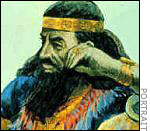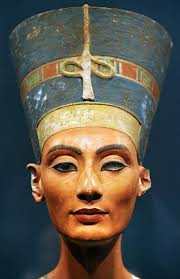Not much else changed with regards to makeup for a long time but in in c. 2500 BC the first tweezers were invented by the Sumerians. They used the tweezers to get rid of unwanted hair and used the flat end to push back cuticles – much like we use them for today 🙂 Other than this the only only makeup activity was in c. 1800 BC when Babylonian men used gold dust to powder their hair.
Once again, proving to be pioneers of makeup history the Egyptians made modifications to their existing concoctions in c. 1500 BC and were using body oils scented with frankincence and myrrh as a way of moisturising their skin to protect from the dry, dusty climate. These body oils and perfumes were valued more highly than cash and in many cases they were used as a form of payment for the Mesopotamian soldiers. By c. 1200 BC the Egyptians were wearing a full fall of cosmetics. They used a copper ore with greenish tones called malachite to create eyeshadows and used a powder made from lead ore as eyeliner.
 In c. 600 BC makeup, along with lavish clothing became a symbol of status worn by all Babylonians of rank. At this time a warrior named Parsondes was thought to have gone King Nebuchadnezzar to complain about the governor having more focus on beauty than on the government. When word got back to Nanarus (the governor) he gave the order that Parsondes shave all his hair and start wearing makeup and perfumed oils.
In c. 600 BC makeup, along with lavish clothing became a symbol of status worn by all Babylonians of rank. At this time a warrior named Parsondes was thought to have gone King Nebuchadnezzar to complain about the governor having more focus on beauty than on the government. When word got back to Nanarus (the governor) he gave the order that Parsondes shave all his hair and start wearing makeup and perfumed oils.
It was after this that makeup seemed to spread and by 400 BC women from various cultures were wearing it. They would add colour to their skin by using a powder made from crushed minerals (the minerals used included ocher, hematite and white lead).
Roman women then made some advancements with colours and in 100 BC they began using saffron or wood ash as eyeshadow and antimony to darken their eyelids, eye lashes and brows. To create a rouge (blusher) and lip colour they would mix a purple pigment called fucus with saliva. Sheep’s fat was used to buff nails and teeth were whitened using pumice.
INTERESTING FACT: In first century BC veins were seen as a sign of beauty – for this reason, blue paint was used to outline them to make them more obvious (and here we are in this moment in history having cosmetic surgery to remove visible veins, lol)
